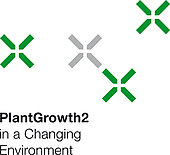PlantGrowth2
In a Changing Environment
 Food, feed, fiber and fuel - Human society is entirely dependent on photosynthetic organisms. Moreover, comprising over 99% of the earth's biomass, photosynthetic organisms have a major impact on the global climate. Therefore, understanding how plants grow and how this growth is affected by the environment are subjects of vital importance.
Food, feed, fiber and fuel - Human society is entirely dependent on photosynthetic organisms. Moreover, comprising over 99% of the earth's biomass, photosynthetic organisms have a major impact on the global climate. Therefore, understanding how plants grow and how this growth is affected by the environment are subjects of vital importance.
The aim of this RTD is to construct mechanistic models that describe growth at different organizational levels (regulatory networks, cells, tissues, organs, whole plant). These individual models will be integrated into an overarching model that can be used to understand plant growth at all levels of complexity.
"PlantGrowth2", the continuation of the 2008-2012 project, focuses on multicellular systems, mechanics and spatial modeling. The main goals of the research project are:
- to study growth quantitatively at the cellular, tissue and whole plant level;
- to apply our basic research to the improvement of lodging resistance in tef, a mechanical problem that is of vital importance in a region of the world where hunger affects human health;
- to promote synergy between plant molecular biology, mathematics, physics and engineering;
- to train a new generation of "systems biologists" who are involved in interdisciplinary projects and can readily cross boundaries between fields because they have acquired hands-on experience in biology, mathematics, physics and engineering.
| Principal Investigator | Prof. Cris Kuhlemeier, Institute of Plant Sciences, University of Bern |
| Involved Institutions | University of Bern, University of Lausanne, University of Fribourg, ETH Zurich |
| Number of Research Groups | 9 |
| Project Duration | Apr. 2013 – Mar. 2017 |
| Approved SystemsX.ch Funds | CHF 2.994 million |
Updated June 2013


